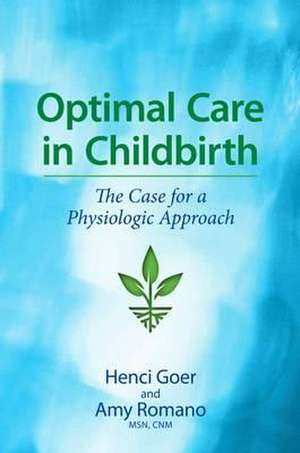Optimal Care in Childbirth
Autor Henci Goer, Amy Romanoen Limba Engleză Paperback – 30 iun 2013
Preț: 179.08 lei
Preț vechi: 206.04 lei
-13% Nou
Puncte Express: 269
Preț estimativ în valută:
34.30€ • 35.34$ • 28.73£
34.30€ • 35.34$ • 28.73£
Carte indisponibilă temporar
Doresc să fiu notificat când acest titlu va fi disponibil:
Se trimite...
Preluare comenzi: 021 569.72.76
Specificații
ISBN-13: 9781780661100
ISBN-10: 178066110X
Pagini: 582
Dimensiuni: 153 x 225 x 33 mm
Greutate: 0.89 kg
Editura: Pinter & Martin Ltd
ISBN-10: 178066110X
Pagini: 582
Dimensiuni: 153 x 225 x 33 mm
Greutate: 0.89 kg
Editura: Pinter & Martin Ltd
Notă biografică
Henci Goer, award-winning medical writer and internationally known speaker, has made it her life's work to analyze and synthesize the maternity care research in order to determine what constitutes safe, effective, satisfying care in childbirth. An independent scholar, she has become an acknowledged expert on evidence-based maternity care. Her first book, Obstetric Myths Versus Research Realities, to which this book is the successor, was a valued resource for childbirth professionals. Wanting to give pregnant women and their families the same access to the research evidence and therefore the ability to make informed decisions about their care, she followed it with The Thinking Woman's Guide to a Better Birth. Over the years, she has written consumer education pamphlets and numerous articles for trade, consumer, and academic periodicals. She served as project director and participated as an Expert Work Group member on the document, "Evidence Basis for the Ten Steps of Mother-Friendly Care" on behalf of the Coalition for Improvement in Maternity Services. Currently, she is a resident expert on Lamaze International's website where she moderates the "Ask Henci" forum and appears as a regular guest blogger on Science & Sensibility. Goer's major in biology at Brandeis University, her teaching experience as a Lamaze certified childbirth educator, and her work as a doula have served her well in her chosen career. Amy Romano has worked in the maternity care field as a clinician, research analyst, educator, and consumer advocate since 2001. In 2010, she joined Childbirth Connection, where she directs the Transforming Maternity Care Partnership, a national effort to improve maternity care quality in the United States. Prior to joining Childbirth Connection, she practiced midwifery in the home, birth centre, and hospital settings and taught in the nurse-midwifery program at the Yale School of Nursing. She also spent six years as a perinatal research and advocacy consultant to Lamaze International, where she analyzed, summarized, and critiqued research for the Lamaze community and launched the award-winning research blog, Science & Sensibility. Romano was also a member of the editorial team for the 9th edition of the landmark women's health book, Our Bodies, Ourselves, released in 2011. She received her undergraduate degree from the University of Michigan and both a certificate and masters' degree in nursing at the Yale School of Nursing. Romano was the 2012 recipient of the Kitty Ernst Award, one of the American College of Nurse-Midwives' highest honours.
Cuprins
Section I: Introduction Chapter 1: Why This Book? The Failure of Obstetric Management Chapter 2: Why This Book? The Failure of Obstetric Research Chapter 3: About This Book: The Nuts and Bolts Section II: The Cesarean Epidemic Chapter 4: The Chase to the Cut Chapter 5: The Case Against Liberal Use of Cesarean Surgery Chapter 6: The Case Against Elective Repeat Cesarean Section III: Optimal Care for Initiating Labor Chapter 7: Inducing Labor: Patience Is a Virtue Section IV: Optimal Care for Promoting Labor Progress Chapter 8: Promoting Progress in First-Stage Labor: Yes We Can Chapter 9: Augmentation: Forced Labor Section V: Optimal Care for Guarding Safety and Wellbeing in Labor Chapter 10: Electronic Fetal Monitoring (Cardiotocography): Minding the Baby Chapter 11: Routine IVs Versus Oral Intake in Labor: "Water, Water Everywhere, Nor Any Drop to Drink" Chapter 12: Epidurals and Combined Spinal-Epidurals: The "Cadillacs" of Analgesia Section VI: Optimal Care for Birthing the Baby Chapter 13: Second-Stage Labor: Lead, Follow, or Get out of the Way? Chapter 14: Instrumental Vaginal Delivery and Fundal Pressure: When Push Comes to Pull - or Shove Chapter 15: Episiotomy: The Unkindest Cut Section VII: Optimal Care for After the Birth Chapter 16: Third-Stage Labor Active Management: The Wrong Answer to the Right Question Chapter 17: Newborn Practices: Don't Just Do Something; Sit There! Section VIII: Optimal Practice for a Maternity Care System Chapter 18: Supportive Care in Labor: Mothering the Mother Versus Serving the Doctor Chapter 19: Midwife-Led Care: Organizing an Optimal Maternity Care System Chapter 20: The Place of Birth: Birth Homes Chapter 21: The Place of Birth: Home Births Appendices Index About the Authors
Recenzii
"Optimal Care in Childbirth: The Case for a Physiologic Approach contains an extraordinary wealth of information, each chapter standing on its own so that it can be read independently. The authors have met with rigor and wisdom their goal of separating 'the wheat from the chaff' in this examination of the scientic literature. They have given a rst-rate resource to the entire maternity care community - health professionals, practitioners, policy makers, administrators, advocates, and interested women. For those who want to bring about needed reform in maternity care, this scholarly and indispensable book has provided the tools. Indeed, Henci Goer and Amy Romano offer a new 'gold standard' to follow for maternity care." Birth: Issues in Perinatal Care "Goer and Romano (2012) untangle the vast web of information about medical and physiologic birth and in doing so have made a major contribution to the birth literature." Journal of Perinatal Education
